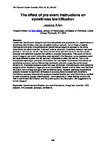The effect of pre-event instructions on eyewitness identification
| dc.contributor.author | Allen, J. | |
| dc.date.accessioned | 2022-12-23T20:47:57Z | |
| dc.date.available | 2022-12-23T20:47:57Z | |
| dc.date.issued | 2022 | |
| dc.identifier.citation |
Allen, J. (2022) 'The effect of pre-event instructions on eyewitness identification', The Plymouth Student Scientist, 15(2), pp. 506-523. https://doi.org/10.24382/82k9-0x76 | en_US |
| dc.identifier.issn | 1754-2383 | |
| dc.identifier.uri | http://hdl.handle.net/10026.1/20126 | |
| dc.description.abstract |
Eyewitness identification research has informed policies and procedures, but experiments on eyewitness identification often use unrealistic testing methods. Part of these unrealistic methods are pre-event instructions given before the participant is exposed to the crime. Instructions can direct attention, thus lead to better accuracy. If previous research had used pre-event instructions, results may have overestimated people’s ability to identify culprits correctly and called into question the validity of previous conclusions. This would not be an issue if usage of pre-event instructions were reported in the literature, as comparisons could be made between studies that did use them or between studies that did not. Due to the inconsistent reporting of pre-event instructions, the true impact of pre-event instructions on eyewitness accuracy and confidence was previously unknown, a gap the current study aimed to fill. A between-subjects experiment was conducted. 623 participants were randomly assigned either detailed or vague pre-event instructions, viewed a crime video, and identified the culprit from a lineup and gave their confidence rating. Receiver operating characteristic analysis revealed no significant difference in accuracy levels between both conditions. Confidence-accuracy characteristic analysis revealed detailed pre-event instructions resulted in more trustworthy suspect-identifications. The implications of these findings for both the field of eyewitness identification and the justice system are discussed, with suggestions for further research. | en_US |
| dc.language.iso | en | en_US |
| dc.publisher | University of Plymouth | en_US |
| dc.rights | Attribution 3.0 United States | * |
| dc.rights.uri | http://creativecommons.org/licenses/by/3.0/us/ | * |
| dc.subject | Eyewitness identification | en_US |
| dc.subject | pre-event instructions | en_US |
| dc.subject | lineup task | en_US |
| dc.subject | attention | en_US |
| dc.subject | ROC analysis | en_US |
| dc.subject | CAC analysis | en_US |
| dc.subject | accuracy | en_US |
| dc.subject | confidence. | en_US |
| dc.title | The effect of pre-event instructions on eyewitness identification | en_US |
| dc.type | Article | en_US |
| plymouth.issue | 2 | |
| plymouth.volume | 15 | |
| dc.identifier.doi | https://doi.org/10.24382/82k9-0x76 |



